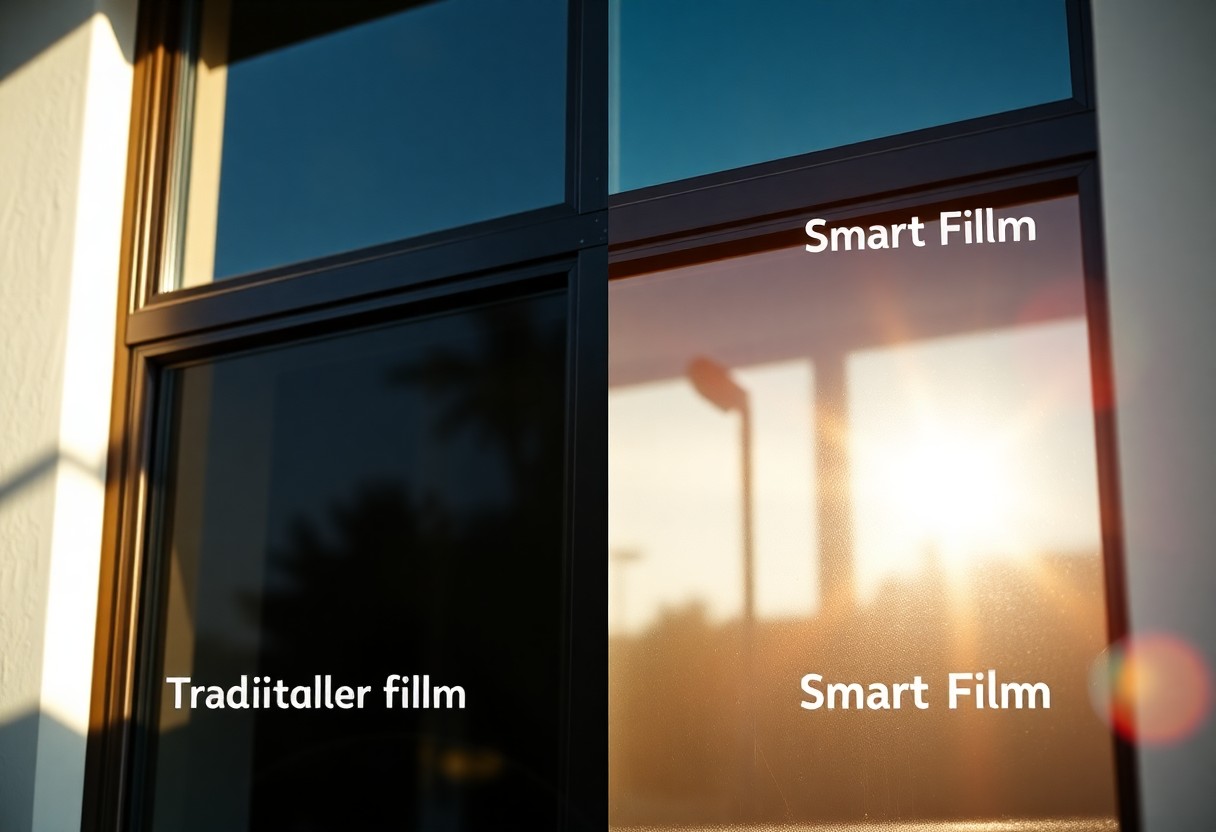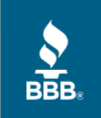Many Komatke property owners face the decision of choosing between smart film and traditional window tinting. Both options have unique benefits and drawbacks that can significantly impact your property’s aesthetics, energy efficiency, and privacy. This post will guide you through the key factors to consider, helping you make an informed choice that best suits your needs and enhances your living environment.
Understanding Smart Film
Smart film technology is revolutionizing how you approach privacy, energy efficiency, and aesthetics in your property. By altering its transparency when an electrical current is applied, smart film can shift from clear to opaque within seconds, offering instant control over light and visibility. This innovative solution integrates seamlessly into your windows, allowing for both functional and stylish applications.
Definition and Features
Smart film, often composed of liquid crystal or polymer dispersed liquid crystal (PDLC), transforms from a transparent state to a frosted appearance when powered. This unique feature embodies functionality, going beyond conventional tints by providing adjustable light control. Advanced options even allow for smart home integration, enabling you to operate the film remotely or through automation systems.
Benefits of Smart Film
One significant benefit of smart film is its ability to enhance energy efficiency by reducing heat gain and glare, ultimately resulting in lower utility bills. Moreover, it provides modern aesthetics and privacy on demand, making it ideal for both residential and commercial spaces. With varied functionalities, smart films cater to diverse needs and preferences, offering solutions that traditional tints simply cannot match.
Beyond energy savings, the versatility of smart film allows for tailored applications in any space. Whether you want to instantly transform a conference room from open to private or create a stylish atmosphere in your living room, you can easily manage lighting and privacy. Additionally, smart film can protect your interiors from UV damage, preserving the lifespan of furniture and flooring. With options to customize opacity levels and integrate with cutting-edge technology, smart film stands out as a forward-thinking choice for your property in Komatke.

Exploring Traditional Tint
Understanding traditional tint requires familiarity with the various types available, each offering unique benefits for home and property owners in Komatke. Unlike smart films, traditional tints involve adhesive films that can be applied to your windows, effectively reducing glare and heat while enhancing privacy. Assessing your needs will help determine the best option for you.
Types of Traditional Tint
- Dyed Films
- Metalized Films
- Ceramic Films
- Hybrid Films
- Low-Reflectivity Films
Any choice of tint can significantly affect your home’s aesthetics and energy efficiency.
| Type | Benefits |
| Dyed Films | Cost-effective with heat reduction. |
| Metalized Films | Reflective properties enhance privacy. |
| Ceramic Films | Superior heat rejection without interference. |
| Hybrid Films | Combines features for balanced performance. |
Advantages of Traditional Tint
One of the main advantages of traditional tint is its ability to reduce heat buildup significantly, keeping your indoor environment cool and comfortable. With a variety of styles and shades, traditional tints can also enhance your property’s privacy while blocking harmful UV rays, protecting both your furnishings and your skin.
This heat reduction can lead to lower energy bills during the hotter months, an appealing aspect for homeowners looking to maximize energy efficiency. Additionally, the aesthetic customization options allow you to select a tint that complements your home’s design, providing an added layer of style. Durability is another significant factor; most traditional tints are built to last, ensuring long-term protection and performance, which brings peace of mind for any homeowner. Investing in traditional tint can ultimately enhance both your comfort and your property’s value.
Key Differences Between Smart Film and Traditional Tint
Understanding the differences between smart film and traditional tint is necessary for Komatke property owners. Smart film offers dynamic control over light and privacy, allowing you to switch from transparent to opaque with the tap of a button. In contrast, traditional tint provides a static solution that primarily focuses on reducing glare and UV exposure. This distinction can significantly impact your decision depending on your needs for versatility versus permanence.
Technology and Functionality
Smart film employs advanced electrochromic technology, enabling you to adjust opacity and transparency on demand, making it ideal for rooms that require variable privacy levels. Traditional tint, however, is a fixed option that blocks sunlight and heat but lacks any adaptive technology, limiting your ability to modify your environment based on your preferences.
Aesthetic Considerations
Regarding aesthetics, smart film presents a sleek, modern look that seamlessly integrates with contemporary architecture. In contrast, traditional tint often has a shiny finish that can clash with various design elements. Smart film’s versatility allows for a choice of opacity levels, blending well with your interior while maintaining a cutting-edge appearance.
Smart film not only enhances the visual appeal of your property but also transforms the way spaces can be used. For instance, in conference rooms, you can switch from full visibility to complete privacy during meetings, giving a polished appearance while promoting a productive environment. The clean lines and unobtrusive design of smart film complement minimalist aesthetics, ensuring your property looks sophisticated and forward-thinking. In contrast, traditional tint may limit your design options and could detract from your property’s overall aesthetic harmony.
Cost Analysis
Initial Investment
The initial investment for smart film tends to be higher than traditional tint options. While traditional window films can range from $500 to $1,500 for a typical home, smart films often start at around $1,500 to $3,000, depending on the size and features. This upfront cost can be a significant consideration for property owners, impacting their decision on which solution to choose.
Long-term Savings
Choosing smart film can lead to substantial long-term savings on energy bills. With smart film’s dynamic control of light and heat, you could potentially reduce cooling costs by up to 30%. In contrast, traditional tints typically provide only passive heat reduction. Over time, these savings can offset the higher initial investment, making smart film a more economical choice for energy-efficient living.
If you consider energy costs over a five to ten-year period, the savings can be significant. For instance, if your monthly cooling bill is $150 and smart film reduces it by 30%, you’d save about $450 each year. Over ten years, that’s $4,500—effectively covering the upfront costs of smart film installation. Furthermore, smart films can enhance the comfort of your living spaces by minimizing glare, potentially improving your home’s value and making it more appealing to buyers if you decide to sell. This long-term perspective often reveals the true financial advantage of investing in smart film over traditional tint.
Installation and Maintenance
The installation and maintenance of smart film and traditional tint are key considerations for Komatke property owners. Each option has distinct processes and upkeep needs that can significantly impact your long-term satisfaction and investment. Understanding these factors will help you make an informed decision that aligns with your property’s requirements and your lifestyle.
Installation Processes
Installing smart film typically involves a professional service to ensure proper application and functionality, as improper installation can affect the electronic capabilities. In contrast, traditional tint can often be a DIY project, though professional installation is recommended for optimal results. Both processes require meticulous preparation, including surface cleaning and ensuring the ambient environment is suitable for adhesion.
Maintenance Requirements
Smart film requires minimal maintenance due to its durable surface, while traditional tint may need more frequent attention to prevent peeling or bubbling. Regular cleaning is vital for both types; however, the methods differ. Smart film can withstand a variety of cleaning materials, while traditional tint benefits from a gentle approach to maintain its clarity and appearance.
For smart film, simply wipe the surface with a microfiber cloth and non-abrasive cleaner to preserve its features. In contrast, for traditional tint, you should avoid ammonia-based cleaners that can degrade the film over time. Prioritizing regular maintenance ensures longevity; for example, a well-maintained traditional tint can last 5 to 10 years, whereas smart film may be expected to exceed that lifespan and remain effective with minimal upkeep. Choose wisely based on your willingness to invest time and effort into maintenance tasks.
Environmental Impact
Both smart film and traditional tint can have significant environmental implications, influencing energy consumption and sustainability. When assessing options, it’s important to consider how each choice affects your property’s ecological footprint, including energy usage, waste generation, and resource conservation throughout their lifecycle.
Energy Efficiency
Smart film offers enhanced energy efficiency by adjusting its opacity based on sunlight, thereby reducing the need for artificial heating or cooling. This can lead to energy savings of up to 30%, making it a more favorable choice for reducing your energy bills while contributing to a smaller carbon footprint.
Sustainability Considerations
When evaluating sustainability, smart film stands out due to its long lifespan and lower environmental impact during production and disposal when compared to traditional tint. Additionally, advanced smart films often utilize recyclable materials, which lessens their overall ecological footprint.
Opting for smart film means supporting innovation in materials that prioritize sustainability. Many manufacturers are increasingly using eco-friendly resources in their smart films, leading to a reduction in harmful waste. For instance, the production of certain smart films can involve less hazardous materials and fewer chemicals, contributing to safer manufacturing practices. When discarded, these films are designed to be easier to recycle, further mitigating their impact on landfills. This aligns with a broader commitment to environmental stewardship, allowing you to make a responsible choice for your property while also enjoying modern conveniences.
Summing up
Ultimately, as a property owner in Komatke, you should weigh the advantages of smart film against traditional tint based on your specific needs and preferences. Smart film offers advanced features like adjustable opacity and energy efficiency, while traditional tints provide cost-effective solutions with proven performance. Consider factors such as budget, aesthetic appeal, and the level of control you desire over light and privacy. Making an informed decision will enhance your property’s value and comfort.





